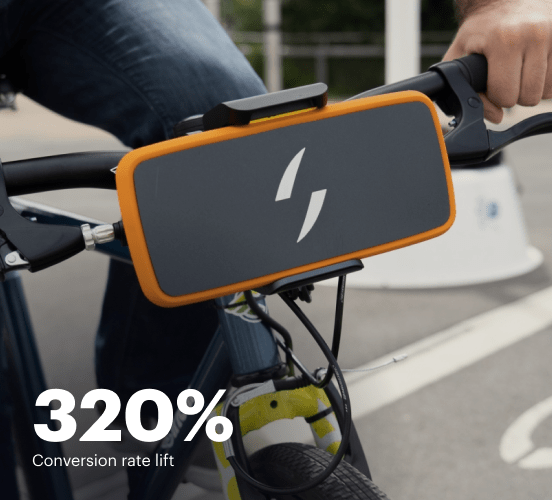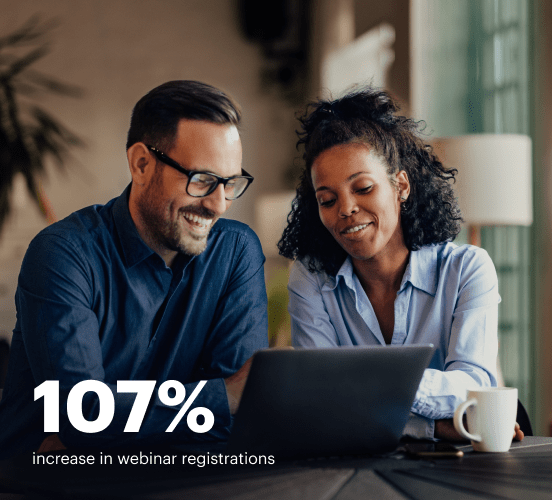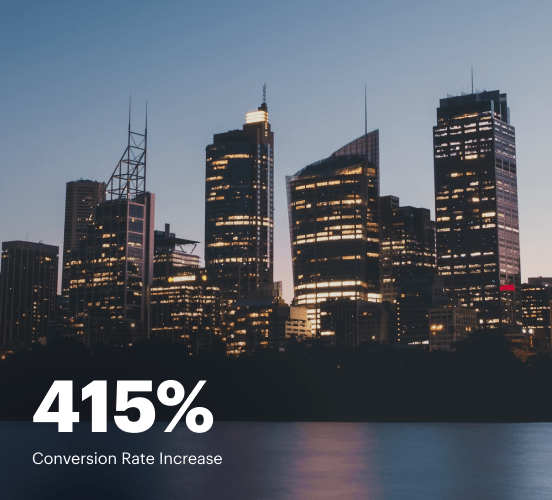Webflow vs. TARS: the best platform for a seamless web experience
Discover how Webflow compares to TARS regarding features and usability. Find out which platform provides the competitive advantage your business deserves.
Get startedSee how Instapage stacks up against the competition
| Feature | Instapage | Other builders |
| Drag-and-Drop Tools | ||
| Conversion-optimized templates | ||
| Manual and AI-powered A/B Tests | ||
| AI content suggestions | ||
| Popups and sticky bars | ||
| Canvas and grid blocks | ||
| Reusable and global elements | ||
| Form and popup builders | ||
| Built-in Heatmaps | ||
| Central analytics dashboard | ||
| Ad-to-page personalization and collections | ||
| Contacts, lists, and email | ||
| Dedicated, full-service CRO experts | ||
| Enterprise-ready platform |
Leading the way in building high-performing landing pages





Why Instapage is the smarter choice for your campaigns
Get everything you need to build, scale, and optimize high-converting landing pages—without coding.

Easier page building without coding
Instapage offers a flexible and seamless page creation experience with a library of 500+ conversion-focused layouts, Instablocks®, a drag-and-drop builder, and AI content generation. With technologies like Thor Render Engine®, you can create on-brand, mobile-responsive landing pages that load quickly and start converting during initial visitor clicks.

More insights — better results
Instapage lets you see in detail how each landing page experience and variation is performing so you can make targeted changes that boost page conversions. Use heatmaps for a better understanding of on-page activities, run A/B tests and AI-assisted experiments, and then track and evaluate results within robust analytics dashboards.

More personalized experiences
Instapage lets you quickly create high-performing landing pages tailored to each of your ad campaigns. Deliver personalized experiences for distinct audiences using dynamic text replacement. Effortlessly align specific advertisements to unique pages with AdMaps. Monitor audience-level metrics using our advanced data tools.

Built-in collaboration
Instapage collaboration capabilities bring your entire team together to speed up the process of landing page review, approval, and launch. No more frustrating and unnecessary revisions or edits scattered across emails. Provide instant feedback, conduct real-time page edits, and securely share your pages with outside stakeholders.

Free up time for your business
Invest time into business growth, not busy work. Launch landing pages faster with reusable forms and templates. Build once, reuse forever.
Explore all integrations






Easier page building without coding
Instapage offers a flexible and seamless page creation experience with a library of 500+ conversion-focused layouts, Instablocks®, a drag-and-drop builder, and AI content generation. With technologies like Thor Render Engine®, you can create on-brand, mobile-responsive landing pages that load quickly and start converting during initial visitor clicks.
More insights — better results
Instapage lets you see in detail how each landing page experience and variation is performing so you can make targeted changes that boost page conversions. Use heatmaps for a better understanding of on-page activities, run A/B tests and AI-assisted experiments, and then track and evaluate results within robust analytics dashboards.
More personalized experiences
Instapage lets you quickly create high-performing landing pages tailored to each of your ad campaigns. Deliver personalized experiences for distinct audiences using dynamic text replacement. Effortlessly align specific advertisements to unique pages with AdMaps. Monitor audience-level metrics using our advanced data tools.
Built-in collaboration
Instapage collaboration capabilities bring your entire team together to speed up the process of landing page review, approval, and launch. No more frustrating and unnecessary revisions or edits scattered across emails. Provide instant feedback, conduct real-time page edits, and securely share your pages with outside stakeholders.
Free up time for your business
Invest time into business growth, not busy work. Launch landing pages faster with reusable forms and templates. Build once, reuse forever.
Explore all integrationsGet started with Instapage in a few steps
-
Create your Instapage account
Start with Instapage by signing up via Google or your email. You'll get access to a free 14-day trial to discover Instapage capabilities. Feel free to cancel anytime during the 14-day trial if you decide that our product is not suitable for your business. -
Build and personalize your page
Create your first landing page from scratch or choose a template from 500+ customizable layouts. Use the drag-and-drop builder to add page elements, fonts, and backgrounds, refine content with AI, or add custom HTML, Javascript, and CSS. -
Review and make edits
Collaborate on page designs and streamline review processes. Invite your team members and stakeholders to review, edit, and provide feedback on your landing page. Collaborate knowing your page is confidential and only accessible to authorized users. -
Publish and track page performance
Publish your page to a domain or custom URL. Connect your pages to the ads you've created and track page performance within the analytics dashboard, run A/B tests and AI experiments, analyze results, and continuously optimize your landing page to maintain high conversions.
Webflow vs. TARS: A Comprehensive Face-Off
Navigating the world of landing page builders can feel like stepping into a boxing ring filled with contenders, each one vying for attention with unique features and promises. In this article, we'll square up Webflow and TARS, two heavyweight platforms that have made their mark in the digital marketing arena. As we dissect their strengths, nuances, and quirks, we'll also give a nod to Instapage, an underdog that’s quietly waiting in the wings, ready to deliver a knockout punch. Hearing the names Webflow and TARS may evoke images of sleek interfaces and innovative design tools, but careful consideration reveals that these platforms offer more than just flashy appearances. With user-friendly capabilities, design flexibility, and robust marketing features, they both offer compelling arguments for themselves. However, understanding the core functions of each platform can guide users toward making an informed decision – and maybe even discovering the best value hidden amongst these competitors.
Introducing the Contenders
Webflow and TARS are no ordinary names in the realm of landing page builders. Webflow is like the artist in the digital marketing ring, giving users the ability to create stunning, visually captivating websites with complex animations and responsive designs. It appeals to designers and marketers alike, offering robust functionalities that push creative boundaries without needing to write extensive code. On the other hand, TARS takes a different approach. It’s primarily known for its dynamic chatbots that enhance user interaction through conversational interfaces. Brands leveraging TARS can foster an engaging and efficient customer experience, making it easier for leads to flow through their sales funnel. Each platform has its unique flair, with Webflow presenting a canvas for expansion and TARS offering a hands-on approach to customer interaction. As we compare them, Instapage emerges as a quietly fierce competitor; its focus on optimizing conversion rates through tailored landing pages provides businesses an edge in achieving marketing objectives without causing design headaches.
Round 1: Feature Face-Off
When we pit Webflow and TARS against each other on the features front, it becomes apparent that both platforms bring their unique strengths to the table. Webflow boasts a plethora of features designed for those who seek depth in design. With capabilities like CMS collections, eCommerce integrations, and advanced animations, it truly allows users to bring their creativity to life. TARS, on the other hand, wins with top-notch conversational AI features, allowing brands to set up chatbots quickly. It's designed for ease of use, letting businesses create interactive experiences without requiring technical prowess. But hang on—before we throw in the towel, there’s Instapage, skillfully sidling into the spotlight with its robust A/B testing capabilities, a suite of customizable templates, and analytics tools that might just put both of these contenders in a real jam. Whether you're looking for finesse in design or a practical approach to user engagement, each platform has its advantages and a keen eye for market trends.
Round 2: User Experience Unleashed
In the ring of usability, both Webflow and TARS cater to different audiences. Webflow can seem like a thrilling roller coaster ride for users navigated by skilled marketers and designers; however, those new to website building might find themselves in a bit of a twist trying to figure everything out. The platform's learning curve can feel more like a learning adventure, which is where its extensive resources come in handy. By contrast, TARS simplifies the experience with a user-friendly interface that enables even the greenest rookie to whip up chatbots in no time. Its visual interface keeps things straightforward, taking the confusion out of customer interactions. The accessibility of TARS allows businesses to launch campaigns faster, letting you focus on marketing strategies rather than grappling with usability hiccups. When considering usability, it is essential to appreciate the artistic potential of Webflow and the straightforward navigation of TARS, while acknowledging that both platforms excel in their unique areas. Instapage elegantly combines ease of use with functionality—making it a formidable opponent for both Webflow and TARS.
Webflow's Winning Features:
- Advanced design capabilities with drag-and-drop functionality
- CMS collections for streamlined content management
- Responsive design adjustments for all device types
- Built-in eCommerce features for online shopping
- Custom integrations with third-party tools and services
TARS' Standout Features:
- User-friendly chatbot builder for quick setup
- Variety of templates for different industries
- Easy integration into existing websites and apps
- Real-time analytics to track chatbot performance
Strengths Shared by Both Platforms:
- Robust customer support resources and community forums
- Mobile optimization for all built landing pages
- Flexible design options to cater to various user needs
- SEO-friendly tools to enhance online visibility
- Integration capabilities with popular marketing platforms
- User base has access to rich tutorials and educational resources
While both Webflow and TARS hold their own in this competitive matchup, it is hard to overlook the impressive capabilities of Instapage as it positions itself strategically. Instapage's design intentions revolve around maximizing conversions, ensuring that you receive not just a well-crafted landing page but one that serves a significant purpose in your marketing journey.
Round 3: Performance Showdown
As we lace up our gloves for the performance round, let’s talk page loading times and mobile responsiveness. In this digital age, users expect lightning-fast load times, and anything less can feel like watching molasses drip in winter—frustrating and far from optimal. Webflow generally handles this well, with robust site architecture contributing to quick loading speeds. However, if there’s even a hint of additional elements slowing things down, it could detract from user experience. TARS, with its streamlined chatbots, doesn’t usually carry baggage that hinders performance and tends to load nimbly even when deployed on multiple platforms. They maintain a strong focus on ensuring that interactions remain seamless, which is vital in keeping potential leads engaged. Yet again, the agile Instapage enters with techniques specifically aimed at improving the conversion process. Its dedicated focus on performance analytics and A/B testing means every element—be it load speed or responsiveness—adds value. With such vital benchmarks on the line, performance significantly influences user experience and conversion rates, making it essential to choose wisely.
Round 4: Support Availability
The support round is critical for ensuring that users receive help when they encounter roadblocks or uncertainties in their journey. Both Webflow and TARS shine in this category, offering various support channels and community resources designed to assist users as they navigate their features. Webflow provides detailed documentation, robust community forums, and access to tutorial videos to enhance user understanding. Moreover, TARS offers strong customer support, ensuring that even if someone struggles with a chatbot setup, they achieve results through guiding resources. Picture both platforms as spirited sidekicks, always ready to offer a quick save or a word of advice. Interestingly, when it comes to the support game, Instapage emerges yet again with its dedicated customer service team and extensive documentation, complementing its platform-wide features to equip users for success.
Round 5: Pricing Breakdown
Webflow's Pricing Strategy Insights:
- Offers a free plan with limited features for beginners
- Tiered pricing for different usage levels and needs
- Specific plans cater to eCommerce users with additional costs associated
- All plans include hosting, ensuring easier management
TARS' Pricing Strategy Highlights:
- Customizable pricing based on volume and usage needs
- Offers a trial period to test the platform before committing
- Options for monthly or yearly billing at discounted rates
- Variety of plans tailored to different business scales
When evaluating the pricing strategies of both platforms, it becomes necessary to consider the flexibility each offers. Webflow provides a range of plans tailored to various customer needs, as does TARS with its adaptable pricing. However, Instapage brings yet another level of value to the table, with features designed to optimize spending. The array of options available ensures users can shop smart, but every platform must be analyzed based on their distinct user goal.
As we lay out the pricing plans, it's crucial to note that while budget constraints matter, the features you gain can occasionally include surprises waiting in unexpected places. Buyers must weigh benefits alongside costs to find the perfect fit for their needs.
Then, There’s Instapage...
Instapage stands as a distinct contender in this landing page showdown, emerging as the mentor that quietly observes from the sidelines. While Webflow shines in creative design and TARS excels in user interaction, Instapage brings forth unique value propositions that focus on optimized page conversion and streamlined user experience. With tailored templates, tested layouts, and user-friendly interfaces, Instapage offers solutions customized to meet diverse business goals. This platform provides insightful analytics, guiding users on how to improve their marketing tactics without overwhelming them with unnecessary features. When looking to maximize returns, businesses may just find Instapage outshining both of its competitors in those respects.
Ultimately, the decision comes down to understanding specific needs, and the potential of each platform to meet them. Emphasizing the power of making educated decisions, we encourage readers to analyze their personal or corporate goals meticulously. In doing so, the right platform—be it Webflow, TARS, or Instapage—could become the key to propelling their marketing efforts to new heights. Each option has strengths and insights that will be pivotal in choosing the next step on your marketing journey.










